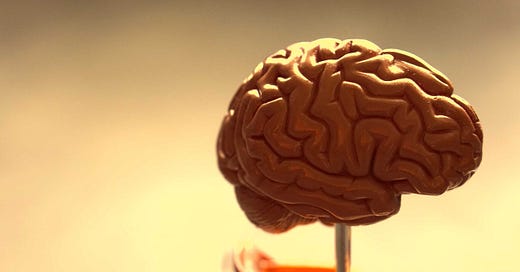Many people have a little Neandertal in the brain. Does it matter?
Research has started to show the ways that introgressed genes from Neandertals affect brain shape in living people.
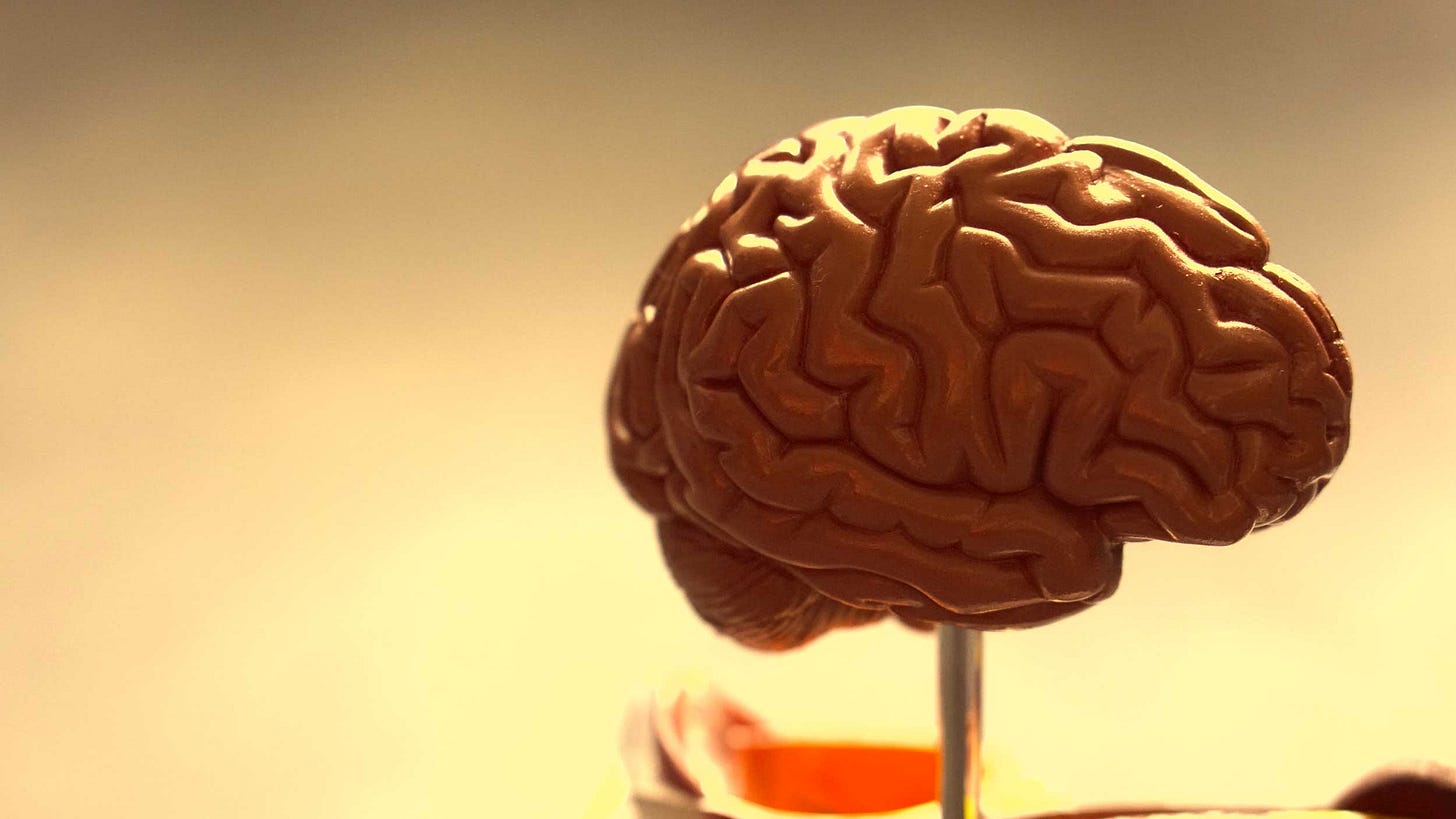
A decade ago ancient DNA revealed that today's people have Neandertal ancestors. Ever since then, scientists have been looking for ways that this genetic inheritance may matter to us.
Across the whole genome, it's clear that some Neandertal genes have made a difference, both good and bad. The most gene-rich parts of our chromosomes are less Neandertal than gene-poor regions, suggesting that many genetic variants from Neandertals may not have worked well after being introduced into later human populations. But a few Neandertal genes are much more common today than the average 2% across our genomes. Those genes were evidently valuable, at least at some times and places. Discovering their functions has been a high priority for researchers.
Many assumed that the brain would be the last place we would find Neandertal genes in action. According to the common story, today's humans outlasted and outcompeted the Neandertals, and we did that by outsmarting them.
But it turns out that human brain tissue has Neandertal genes humming along just like the rest of our bodies. For the most part, Neandertal genes seem to be plug-and-play replacements for the “modern” equivalents. Some genes from Neandertals even seem to make people's brains shaped a little more like these ancient people.
Genes and brains beyond FOXP2
Neuroscientists have come a long way over the last two decades in understanding how genes make a difference to the brain. They began with a very limited knowledge of genetic variation and samples of a few dozen research participants who could be studied with MRI scans. With these small samples, researchers could only study genes that might have really big effects. They focused on the limited number of genes that were known to have catastrophic effects on brain or cognition when a mutation disrupted the gene's function. Many hoped that so-called candidate genes might give a clue about the network of genes that build our brain functions.
It was this approach that led geneticists to the gene known as FOXP2. The gene was first identified in 1998 by researchers studying a family in which several members carried a mutation that caused a developmental disorder of language. A few years later, other scientists found that the area around FOXP2 showed very little genetic variation across human populations. This finding led to speculation that natural selection may have affected FOXP2 during recent human evolution, possibly favoring brain functions that enabled humans to speak or understand language better.
Today we have a lot more information about the variation of FOXP2 but little clarity about its possible importance. The protein coding sequence of FOXP2 differs slightly between chimpanzees and humans, but the protein sequence does have some variation across humans worldwide. In fact a fraction of people today have the same coding sequence found in Neandertals, showing that the gene itself worked very much the same in ancient and living groups.
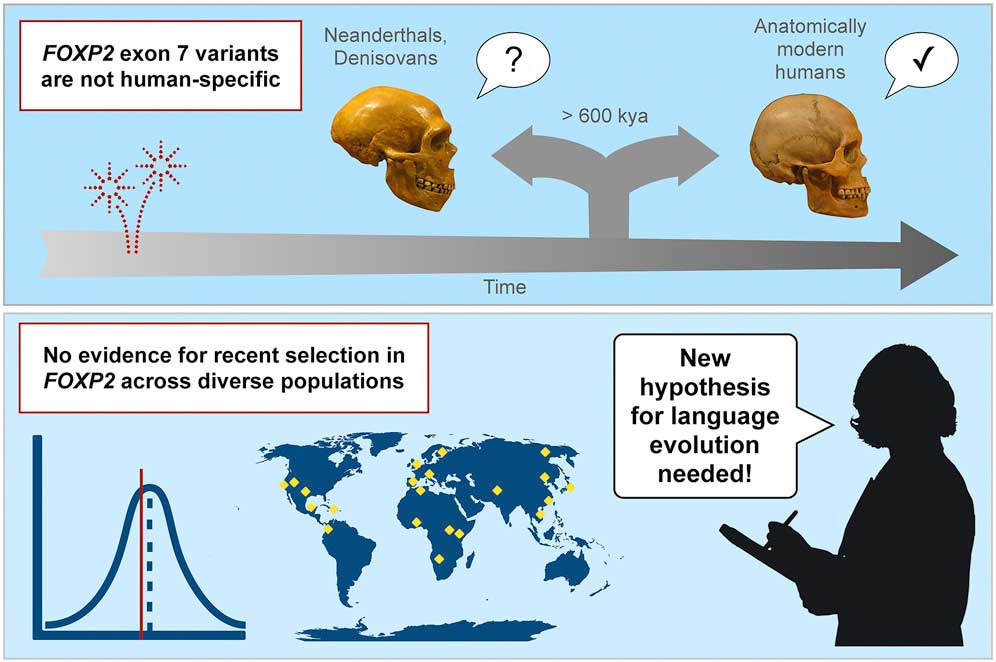
In 2014, Benjamin Vernot and Joshua Akey showed that a wider region of chromosome 7 around the FOXP2 gene is depleted of Neandertal ancestry. Something in this region mattered enough to select against the variation from Neandertals, during the first few generations after their population mixed into our own. But we don't yet know what the target of that selection might have been. It is possible that the Neandertal FOXP2 gene itself was an innocent bystander of selection on some other gene.
The FOXP2 story shows many of the drawbacks of the candidate gene approach. Behavioral traits like language development are not like blood types where a single Mendelian gene makes a large difference to their variation. Genes do affect brains and behavior, but most of those effects are highly polygenic, spread across hundreds of genes across the genome. When the genetic variance of a trait is spread across hundreds of loci, each one of them accounts for at most a small fraction of the variation of the trait. To study such effects requires immense sample sizes.
Over the last decade, neuroscientists have scaled up studies of brain morphology to include tens of thousands of people. A recent meta-analysis looked at how DNA variation affects cerebral cortex variation across a sample of more than 30,000 people of European ancestry, combining the large ENIGMA study that took MRI brain images from countries across Europe and a part of the UK Biobank study. This study identified gene variants that are associated with several measures of brain morphology.
In research published in 2020, Amanda Tilot and coworkers began to look at how these brain genes evolved in ancient people. They considered genes associated with measures of the surface area of the cerebral cortex, including the sizes of various areas of the cortex. What they found was that the genetic variants associated with cortical surface measures were more likely to have been subject to polygenic selection during the last few thousand years. Cortical surface may have been evolving fast in ancient populations.
But it wasn't more or less affected by Neandertal genetic variation. The gene variants that introgressed into recent populations from Neandertals are neither enriched nor depauperate within the associations for cortical surfaces. The Neandertal genes are there, plugging away just like the rest of the human genome.
Neandertal brain shape
Brain tissue does not often fossilize, and we've never found a Neandertal or other human of their time with preserved portions of their brain. This leaves us with no information about the shape or structure of their brains other than the inside surface of the cranial vault.
Neandertal brains were similar in size to humans today. Two aspects of cranial vault shape explain most of the difference between endocranial surfaces in Neandertals and recent people. The Neandertal cranial base is longer and less angled, giving a more elongated shape to their endocranial surface. Compared to Neandertals, most recent people have a bulging parietal lobe. Together these two differences give humans a more compact, globular shape to their brain.
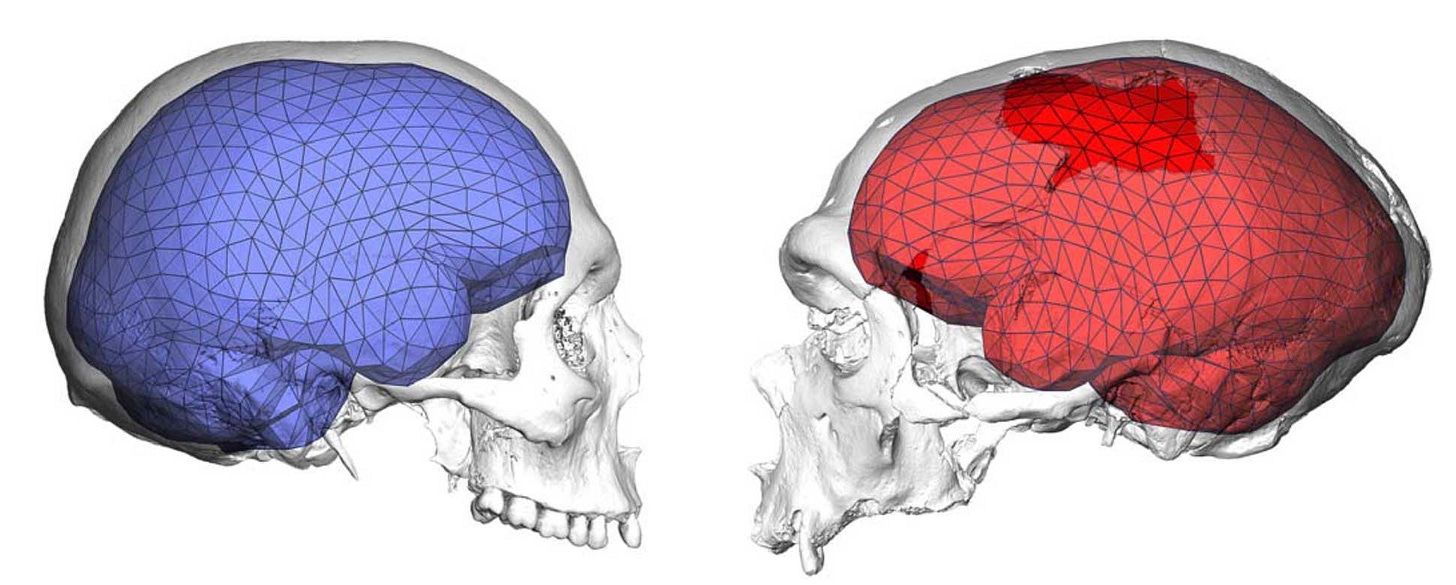
Simon Neubauer, Philipp Gunz, and their collaborators have led several studies of endocranial shape in fossil humans. They have shown that early Homo sapiens skulls from Africa, like the 300,000-year-old fossils from Jebel Irhoud, Morocco, do not have the globular shape of recent humans. The changes in brain shape that make us different from Neandertals seem to have evolved within the last 100,000 years. What difference these changes may have made to brain function, if any, is not yet known.
In 2017, Michael Gregory and coworkers published research trying for the first time to find effects of Neandertal ancestry on recent human brains. At the time, few gene variants were known to be associated with brain morphology. Gregory's team calculated what they called a “NeanderScore”, representing the overall number of Neandertal variants in each research subject's genome. This is more or less what consumer genomic companies like 23andMe do when they report on a person's Neandertal ancestry. The researchers then looked at skull and brain scans. An area stretching from the side toward the back of the skull did indeed seem to be more elongated in people with a higher number of Neandertal variants. It looked like a hint of a Neandertal shape might still be there, correlated with the NeanderScore. Still, the study was fairly small, with just 146 participants, meaning that it really didn't have the power to find small genetic effects. Only one Neandertal genetic region met the statistical conditions for association with brain form.
Later research by Philipp Gunz and collaborators examined a much larger sample of more than 4000 people. In their larger sample, the one gene region found by Gregory and collaborators did not replicate. But from their dataset, Gunz and team were able to identify more gene variants found more often in people with less globular brains, and a handful of these came from Neandertals. One way or another, a few Neandertal genes are making a difference to the shapes of people's brains today, at least in some populations.
Does brain shape matter?
While studies of the genetics of brain morphology and behavior have come a long way, they are still very incomplete. People today carry thousands of introgressed genes, but most of them are rare. The infrastructure and funding for combined brain scans and DNA genotyping of thousands of people has come furthest in western Europe. Only there have samples become large enough to examine associations of genes and brain phenotypes with enough power to find possible effects of rare gene variants. In the rest of the world people have slightly different genetic backgrounds and environments. Future studies in places other than Europe may discover other patterns of relationship between Neandertal variants and phenotypes. Such studies may also find that Denisovan and other sources for introgression have their own role. So the door is not yet fully open to see what effects Neandertal and other introgression have on brain and behavior.
The work by Amanda Tilot and coworkers on cortical surface areas may give a hint about the overall picture of Neandertal introgression. That study found that Neandertal genes make neither more nor less of a difference to cortical surface areas than other genes.
Why would Neandertal genes not make more of a difference, if their brains were shaped differently from ours? Neandertal genetic variants in today's people had to survive an initial process of selection that over a short time culled several large regions of Neandertal chromosomes. Whatever Neandertals had that was linked to FOXP2 never made it into recent human ancestors. The rest of their genes persisted, mostly at low frequencies, for more than a thousand generations. Such long persistence would have been impossible if the remaining Neandertal genetic variation had been very bad for survival or reproduction of individuals who carried it. So the effects of Neandertal genes don't stand out much today from the variation that humans have from African ancestors.
What's interesting is that some Neandertal genes are still altering the shapes of people's brains. That gives an important clue about how our brains evolved. We already know the genes were not strongly disadvantageous. If their effect is on brain shape, then the shape could not have been strongly disadvantageous either. The fact that current populations may still have residual echoes of the shapes of Neandertal brains suggests that they could not have worked very differently from each other.
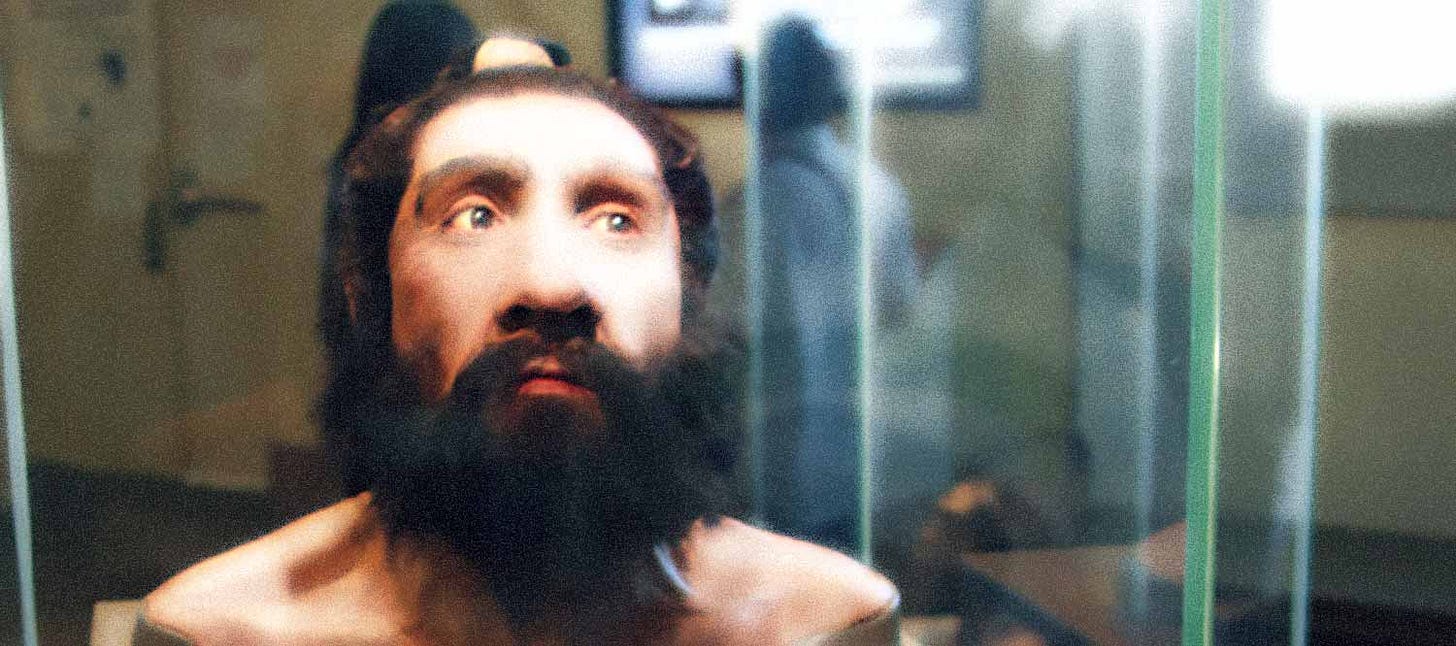
Indeed, we have other evidence that overall brain shape doesn't matter much today. People still vary a lot in endocranial shape. Some people have wider and more rounded endocranial shape, some have longer and narrower endocasts. Similar observations of gross cranial shape have been part of anthropology since before Darwin.
Those shape differences that were so important to nineteenth-century anthropologists don't seem to make any difference to how brains work. With large studies in recent times, neuroscientists have a more detailed picture of variation of brain form. Variation in overall brain volume, cortical gray and white matter, and the relative sizes of some cortical regions all have been found to correlate with various cognitive or behavioral measures. But the variations of endocast and cranial shape once studied by anthropologists do not correlate with those internal measures of brain structure.
Could Neandertal brains have worked just the same as today's people, despite their difference in shape? I think that whatever differences existed would have involved details of the internal structure of the brain, probably unmarked on the inner surface of the skull. One variable we can measure does relate to function within living human populations: brain size. In this measure, Neandertals and recent humans were more or less the same. The way the Neandertal brain worked may not have been exactly the same as ours, but I bet we will find they were not as different as many scientists once imagined.
Notes: In this piece I did not comment on brain development, which is a fascinating subject. Fossil samples have grown to the point where researchers can look at the pace and pattern of skull development in Neandertal children. There's a developing debate about what these patterns show, with Neubauer and Gunz deeply involved on one side, and the University of Zurich anthropologists Christoph Zollikofer and Marcía Ponce de León on the other.
The FOXP2 story has involved many twists and turns over the years. It entered scientific lore as a “language gene” but the reality is much more complicated. I've written about FOXP2 many times but the facts have changed so much that I have taken many of these posts offline as no longer reflecting current knowledge. One that reamins is: The FoxP2 protein sequence from Neandertals and Denisovans is shared by many people today.
References
Atkinson, E. G., Audesse, A. J., Palacios, J. A., Bobo, D. M., Webb, A. E., Ramachandran, S., & Henn, B. M. (2018). No Evidence for Recent Selection at FOXP2 among Diverse Human Populations. Cell, 174(6), 1424-1435.e15. https://doi.org/10.1016/j.cell.2018.06.048
Dannemann, M., Milaneschi, Y., Yermakovich, D., Stiglbauer, V., Kariis, H. M., Krebs, K., Friese, M. A., Otte, C., Lehto, K., Penninx, B. W. J. H., Kelso, J., & Gold, S. M. (2022). Neandertal introgression partitions the genetic landscape of neuropsychiatric disorders and associated behavioral phenotypes. Translational Psychiatry, 12(1), Article 1. https://doi.org/10.1038/s41398-022-02196-2
Gregory, M. D., Kippenhan, J. S., Eisenberg, D. P., Kohn, P. D., Dickinson, D., Mattay, V. S., Chen, Q., Weinberger, D. R., Saad, Z. S., & Berman, K. F. (2017). Neanderthal-Derived Genetic Variation Shapes Modern Human Cranium and Brain. Scientific Reports, 7(1), Article 1. https://doi.org/10.1038/s41598-017-06587-0
Gregory, M. D., Kippenhan, J. S., Kohn, P., Eisenberg, D. P., Callicott, J. H., Kolachana, B., & Berman, K. F. (2021). Neanderthal-Derived Genetic Variation is Associated with Functional Connectivity in the Brains of Living Humans. Brain Connectivity, 11(1), 38–44. https://doi.org/10.1089/brain.2020.0809
Gunz, P., Tilot, A. K., Wittfeld, K., Teumer, A., Shapland, C. Y., van Erp, T. G. M., Dannemann, M., Vernot, B., Neubauer, S., Guadalupe, T., Fernández, G., Brunner, H. G., Enard, W., Fallon, J., Hosten, N., Völker, U., Profico, A., Di Vincenzo, F., Manzi, G., … Fisher, S. E. (2019). Neandertal Introgression Sheds Light on Modern Human Endocranial Globularity. Current Biology, 29(1), 120-127.e5. https://doi.org/10.1016/j.cub.2018.10.065
Neubauer, S., Hublin, J.-J., & Gunz, P. (2018). The evolution of modern human brain shape. Science Advances, 4(1), eaao5961. https://doi.org/10.1126/sciadv.aao5961
Tilot, A. K., Khramtsova, E. A., Liang, D., Grasby, K. L., Jahanshad, N., Painter, J., Colodro-Conde, L., Bralten, J., Hibar, D. P., Lind, P. A., Liu, S., Brotman, S. M., Thompson, P. M., Medland, S. E., Macciardi, F., Stranger, B. E., Davis, L. K., Fisher, S. E., & Stein, J. L. (2021). The Evolutionary History of Common Genetic Variants Influencing Human Cortical Surface Area. Cerebral Cortex, 31(4), 1873–1887. https://doi.org/10.1093/cercor/bhaa327
Vernot, B., & Akey, J. M. (2014). Resurrecting Surviving Neandertal Lineages from Modern Human Genomes. Science, 343(6174), 1017–1021. https://doi.org/10.1126/science.1245938

